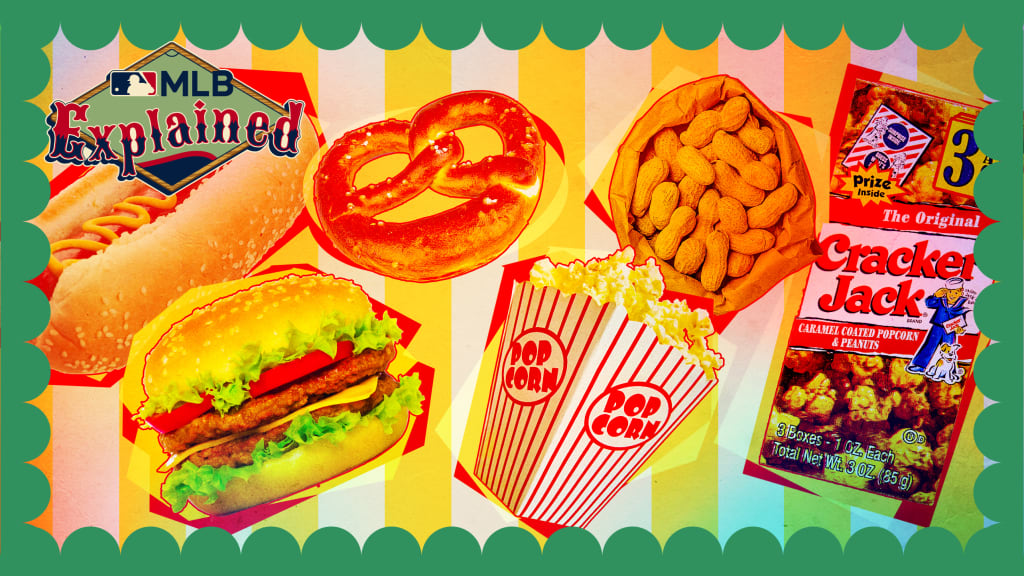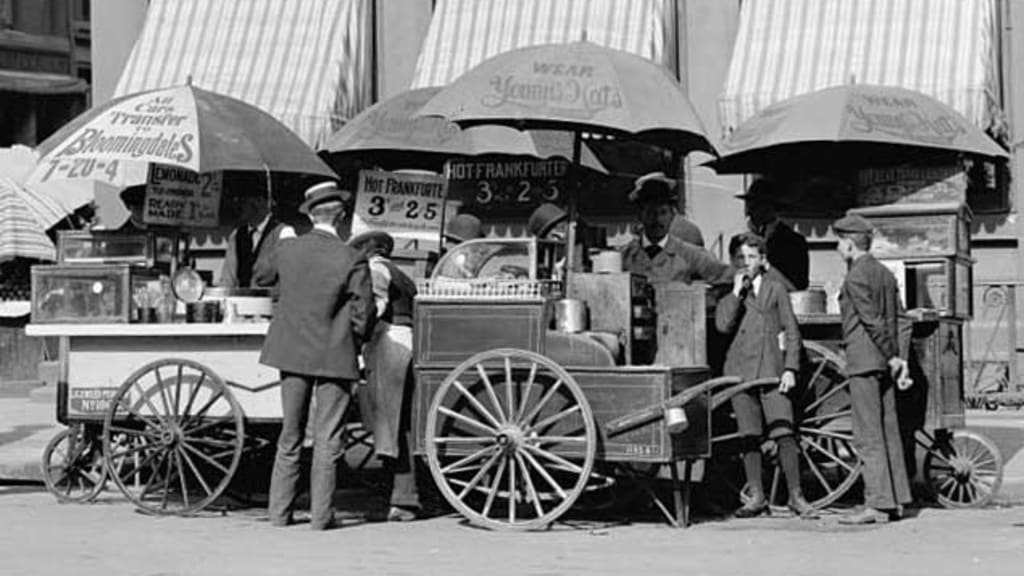
For seemingly as long as there have been ballparks, there's been ballpark food. It just feels right, as much a part of the game as bat flips or bright green grass -- as Humphrey Bogart once said, "a hot dog at the game beats roast beef at the Ritz," and we'd never dare question the judgment of a man who looked that good in a fedora.
Still, we couldn't help but wonder: Why do our ballpark menus look the way they do? Who decided that hot dogs were the perfect complement to a ballgame? Who do we have to thank for inventing stadium nachos? Where did that little novelty batting helmet come from? You have questions, we have answers, one concession at a time.
Why are hot dogs the quintessential ballpark food?
The history of the hot dog dates way back -- as far back as the 8th century BC, when Homer roasted Odysseus in the "The Odyssey" by saying he tossed and turned like "a sausage with fat and blood."
Baseball took a little longer to come around. In the game's infancy, there were no organized concession stands: The only food available was the food that locals came to the game and tried to sell, and fans were naturally drawn to what they could eat with their hands -- things like sandwiches and ice cream. "The old-time umpires were accorded the utmost courtesy by the players," Ohio's Marion Star newspaper wrote in 1916.
They were given easy chairs, placed near the home plate, provided with fans on hot days and their absolute comfort was uppermost in the minds of the players. The umpire always received the choicest sandwiches and the largest glass of beer."

Around the turn of the century, though, the concession game changed. Thanks to a steady influx of German immigrants -- and the 1893 World's Fair in Chicago -- people across the country had begun to fall in love with dachshund sausages, traditionally served with a milk roll and sauerkraut.
Origin stories abound as to just how those sausages became hot dogs. Some point to a St. Louis butcher named Anton Feuchtwanger, who kept loaning white gloves to his patrons to help them hold the piping hot sausages he was selling ... until most of the gloves went unreturned, inspiring Feuchtwanger to come up with a long, soft roll to do the job instead. Some point to Charles Feltman, who opened the first sausage stand on Coney Island and turned it into an empire (until his bread slicer, Nathan Handwerker, broke away and opened a stand of his own). Some point to a cold day at the Polo Grounds in 1901, when a New York Post cartoonist tried to capture vendors hawking a snack he'd never seen before -- except he couldn't spell "dachshund," so he depicted them shouting "get your hot dogs!" instead.
We might never know the truth. But we do know how hot dogs became ubiquitous at ballparks, and we have Great Britain to thank. Harry Stevens emigrated from London to Ohio in the 1880s, and almost immediately fell in love with baseball. He saw the demand for snacks at the ballpark, and decided that all he needed was the business model: one company that could provide a whole stadium's worth of food, making sure every fan got what they wanted. Before long, Harry M Stevens Inc. was bringing hot dogs, soda and peanuts to parks across the country -- and America took its first step down the road towards hot dog cannons.
Wait, why is it "buy me some peanuts and Cracker Jack"?
As it turns out, German sausages weren't the only thing that became a hit at the 1893 World's Fair. Frederick Rueckheim and his brother, Louis, ran a popcorn cart in Chicago, and over the years they tinkered with their recipe, eventually adding peanuts and molasses in an attempt to stand out from the competition. Their easily portable snack -- dubbed "Cracker Jack" after a company salesman's reaction the first time he tried it -- became a hit at the expo, and soon spread across the country and its ballparks ... so much so that Jack Norworth, a 29-year-old vaudeville entertainer who had never been to a baseball game in his life, name-dropped it in a new song of his, "Take Me Out to the Ball Game."
Within a month, "Take Me Out" had skyrocketed up the charts, and Cracker Jack became synonymous with our national pastime. (As for boiled peanuts, well, they'd been a staple dating back to the Civil War: Soldiers packed them as a cheap and tasty source of protein, and after the war ended, vendors responded to that newfound demand.)
How the Rangers invented stadium nachos
It seems impossible to imagine a concession stand without that tray of nachos beckoning in your direction. But it's a relatively new invention -- stadiums didn't start offering it until 1976, when the Father of Nachos changed everything.
Nachos had been popular in Texas for decades. But they hadn't made the leap to sporting events for one simple reason: No one had found a way to produce them as quickly and cheaply as ballparks required. Until Frank Liberto, that is.
Liberto devised a cheese sauce -- according to FDA standards, it can't legally be referred to as "cheese" -- that only required a little added water and leftover juice from jalapeños, creating a gooey orange consistency that could be easily dispensed from a pump. (The recipe is such a heavily-guarded secret that, in 1983, a 29-year-old man was arrested for trying to buy the trade secret.) It came in cans, didn't need to be refrigerated and enabled concession stands to give customers their order within a minute or two, and before long, it had taken off: Liberto sold the Rangers on his big idea, and in its first season at Arlington Stadium, nachos brought in $800,000 in sales. For comparison, the previous high seller, popcorn, brought in $8,500.
The Dallas Cowboys caught on next, and after Howard Cosell hyped them up on Monday Night Football, the rest was history.
Why sunflower seeds?
Seeds first popped up in the big leagues in the 1950s, with Hall of Famers like Enos Slaughter and Stan Musial among their biggest fans -- they were packed with protein and vitamins, they were salty and, most importantly, their shells were endlessly chewable, a welcome distraction for players who were searching for a healthier alternative to chewing tobacco. It wasn't until the late 60s, however, that Reggie Jackson turned them from a fad to a full-blown phenomenon.
Mr. October wasn't an idle seed chewer. He was a believer. “The nutritional value is meaningful," he told Sports Illustrated. "[They have] protein, thiamine, niacin, iron, magnesium, phosphorus. We have to take phosphorus pills to keep from pulling muscles.” Terry Foster of the Dodgers swore that Reggie was the best chewer he'd ever seen, capable of popping a handful of seeds in his mouth and spitting out the shells all in the course of one play.
If it was good enough for a guy who hit 563 career homers and has his own video game, it was good enough for everybody else, and much to the chagrin of grounds crews everywhere -- all those husks weren't the easiest to clean up -- sunflower seeds caught on.
